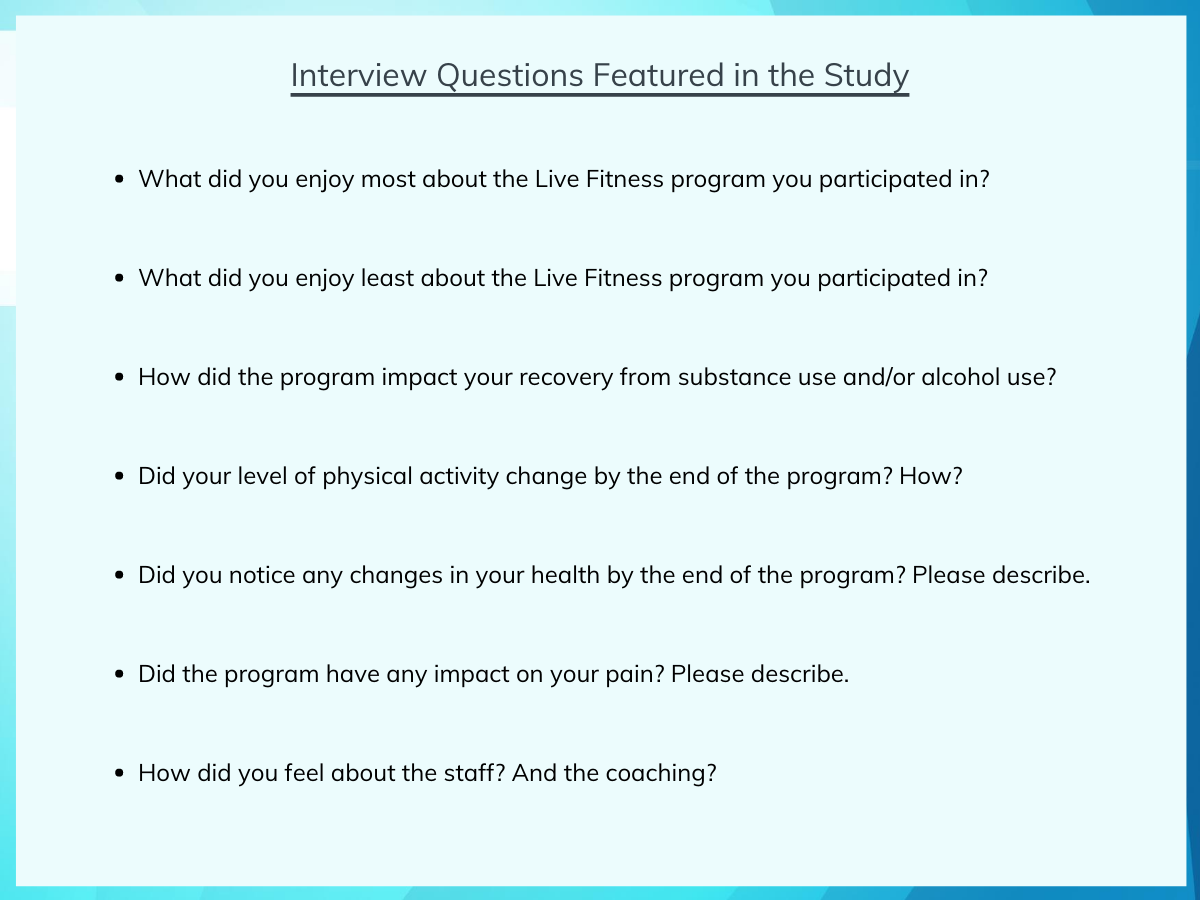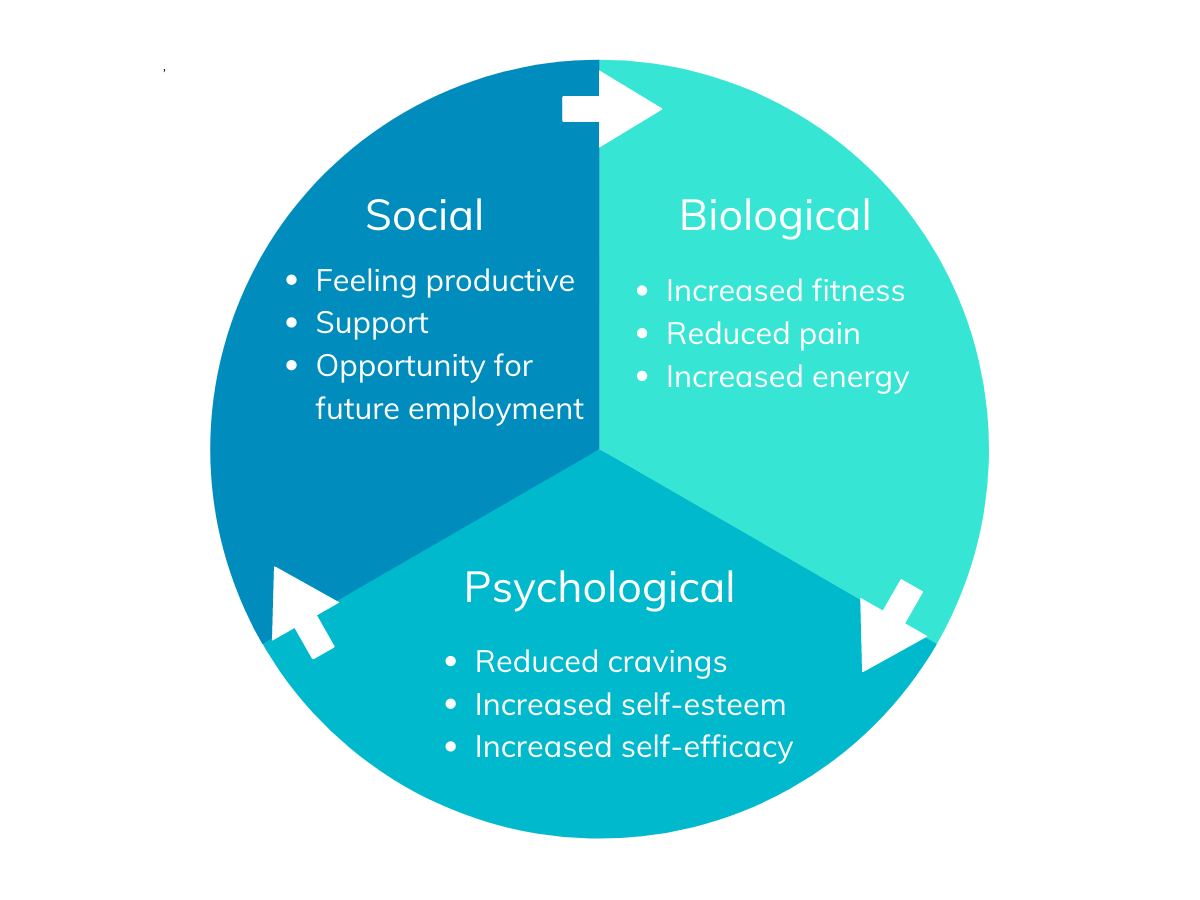Getting work while working out: The potential benefits of a vocational fitness program added to residential SUD treatment
After decades of primarily focusing on medical treatment and mutual help for individuals seeking substance use disorder (SUD) recovery, there is growing interest in the role of employment resources and other supports. This study investigated individuals who completed a vocational fitness program, to learn more about how this program – intended to enhance well-being – might provide benefit.
WHAT PROBLEM DOES THIS STUDY ADDRESS?
Professional medical treatment and mutual help organizations typically serve as the main sources of support for individuals seeking recovery from substance use disorder (SUD). However, there is growing recognition of the broader needs of many who seek treatment for SUD. Limited access to income, stable housing, and other basic resources are common, and these challenges, and the related stress, can present barriers for sustained recovery.
Active SUD is characterized by continued substance use despite negative consequences in various life areas, and prolonged unemployment is especially common among those with more severe SUD. Many people also experience legal consequences related to their use which may make it difficult to find employment even after problems with substance use have resolved. Efforts to support employment goals during the recovery process may help to address these challenges and increase the likelihood of sustained recovery. While financial stability and related outcomes, including a safe and stable housing situation, are some of the most direct benefits of employment support, additional benefits of stable employment may include increased self-confidence and sense of connection with one’s community.
There is also growing interest in the potential benefits of exercise for SUD. Physical activity is associated with improved mood and physical resilience that can also help to prevent or slow the course of common chronic health conditions which may be more prevalent among individuals in recovery from SUD.
In order to integrate these two promising areas of research, the authors of this study set out to take a first look at participants’ experience of a program designed to incorporate employment support and physical fitness for individuals in residential treatment for SUD.
HOW WAS THIS STUDY CONDUCTED?
This was a qualitative evaluation of a vocational fitness program with 26 focus group participants who were asked to share their experiences after completing the 12-week program. The researchers conducted a total of four focus group interviews, with four to 10 participants each. The interviewers asked each group a set of broad, pre-defined questions (e.g., “What did you enjoy most/least about the program?”), following up with specific questions that were guided by participants’ initial responses (this is called a “semi-structured” interview). The 26 study participants were part of a larger group of 53 total individuals (49%) who were introduced to the program, and, of those, 34 who completed it.

Figure 1.
The program itself was offered by a local fitness center to residents of an addiction treatment program which was within walking distance of the facility. Residents who were interested in a career related to the fitness industry were invited to participate in the 12-week program, which met five times per week. These meetings consisted of two lecture-format courses and three exercise sessions each week, and participants could use the facility before or after the meetings as well. Participants who completed the program could apply for entry level positions or an internship in personal training.
The focus groups were recorded and transcribed, and the researchers used a method known as “qualitative analysis” to identify themes in the participants’ responses to interview questions. Qualitative research is often used during the earliest examination of a research question. It allows researchers to take a broad look at a phenomenon or intervention, rather than testing a specific hypothesis using established assessment measures. In this way, qualitative analyses are often used to generate hypotheses to be tested in future research. For this study, it provided the researchers with a framework for systematically coding and reporting on the themes that emerged during focus group discussions.
WHAT DID THIS STUDY FIND?
Participants reported the program helped with both the mental and physical aspects of their recovery.
Various participants described feeling their sense of confidence to handle challenges (i.e., self-efficacy) increase over the course of the program. They also commented on the personalized feel of the program, as many already had interests in fitness. Finally, some participants described decreased cravings for substances over the course of the program.
Participants also described physical benefits, including improved fitness outcomes, from participating.
Focus group members reported seeing measurable benefits in their overall fitness levels. They also described decreases in chronic pain as well as increased energy. Participants also appreciated the nutrition education, noting that applying this knowledge also helped improve their physical well-being.
The program also provided members with a path towards regaining a sense of community.
The final theme that emerged in members’ experience of the program was its role in helping them regain a sense of community. Members reported feeling productive and supported by staff members at the fitness facility. They also described using the knowledge and tools they gained to build structure in their lives. Finally, they appreciated the opportunity to pursue employment with a group of people who had observed them over the course of the program.

Figure 2. The things that participants reported liking and experiencing as a result of the fitness involvement fell into three broad domains.
WHAT ARE THE IMPLICATIONS OF THE STUDY FINDINGS?
The authors of this study found that participants in a vocational fitness program reported benefits across a number of important areas. As shown in the figure above, the themes that emerged from the focus groups they conducted were consistent with a biopsychosocial model of well-being and recovery, in that they included benefits that were biological, psychological, and social in nature.
Employment is a particular area of need for many who are working to resolve (or have resolved) a SUD. Recent data from the National Recovery Study showed that individuals who reported resolving a problem with alcohol or drugs were less likely to be employed or retired compared to the general population. In addition to the role of employment for meeting basic needs, improvements in employment status are also associated with better SUD treatment outcomes. Similar programs have highlighted the potential benefits of employment for community engagement and addressing stigma as well. Addressing employment challenges for individuals in recovery is such a critical issue that it has even been the focus of congressional hearings in the US.
The promise of exercise programs for improving recovery outcomes is also a growing area of interest. While there is some research showing that exercise can reduce relapse risk for people in treatment for alcohol use disorder, one meta-analysis suggested that exercise has more of an effect on mood and physical fitness, but may not affect alcohol use outcomes directly. Nonetheless, these improvements could be helpful for sustaining recovery in the long-term, and the community aspect of exercise interventions such as the one in the current study may confer additional benefits. If this is indeed the case, it would also support programs that follow a mutual help model for improving fitness, including Phoenix Multisport, which, unlike the business in the current study, is fully owned and operated by people in recovery. Such models may also have particular appeal for young people who often are difficult to engage in standard models of care but may be attracted to and more engaged by more active models that have therapeutic potential.
With its focus on employment, community engagement, and physical and mental well-being, this study also aligns with the growing movement to build out existing models of care to address the broader needs of individuals who are seeking long-term recovery from SUD.
- LIMITATIONS
-
- This study did not assess whether the program was effective for improving recovery outcomes. Rather, it was a very preliminary look at participants’ reaction. Future research would need to examine the effectiveness of the program for improving the lives of those who participate.
- Program participants were self-selected, meaning that only residents who were interested in physical fitness were involved in the program at all. The focus group participants were also volunteers, and had completed the program, and may have been more likely to emphasize the positive aspects of the program.
BOTTOM LINE
- For individuals and families seeking recovery: This study found that people who participated in a 12-week vocational exercise program reported several benefits to their recovery, physical health, and sense of community. Many people who are in recovery have difficulty finding employment, and programs designed to support these efforts are a great resource if they are available in your community. The exercise benefits reported by participants in this study have also been documented elsewhere, and increasing physical activity (if it is an option for you) is likely to help improve your mood, energy, and overall health and resilience.
- For treatment professionals and treatment systems: This study found that people who participated in a 12-week vocational exercise program reported a number of benefits to their recovery, physical health, and sense of community. The employment challenges faced by individuals in recovery from SUD are real, as are the likely benefits of efforts to support employment. Opportunities to increase physical activity are also promising for improving mood and physical well-being during SUD treatment. More broadly, this study highlights the potential benefits of partnerships between treatment centers and community businesses and organizations that can help meet patients’ broader recovery needs.
- For scientists: This qualitative study was an initial examination of a vocational fitness program offered to residents of an addiction treatment program by a local fitness facility. Participants described a number of benefits from this program which fell across all domains of the biopsychosocial model of well-being. This fits with the broader literature supporting the role of supported employment and exercise in improving SUD outcomes. This particular study was limited in that focus group participants were volunteers and had completed the entire program, so they may have been more likely to express positive views of the program. Future work should test the effects of programs like these in rigorous and longer-term clinical trials. Long-term follow up studies may also help to determine whether early improvements in mood and physical health (with minimal change in alcohol use) will translate into longer-term improvements in substance use outcomes, and whether community components (i.e., versus individual exercise support) are necessary for broader positive outcomes.
- For policy makers: Participants in this study described a range of psychological, social, and physical health benefits after completing a 12-week vocational exercise program through a local fitness center. These benefits are consistent with the broader body of research showing the benefits of employment support and physical activity during SUD treatment. At a policy level, facilitating partnerships between treatment centers and community businesses and organizations (such as fitness centers) may provide valuable opportunities for re-engagement with the local community and improved health outcomes.
CITATIONS
Stevens, M., Hubbard, E., & Leutwyler, H. (2020). Tools you’ll have for the rest of your life: A qualitative evaluation of a fitness and vocational training program for substance use recovery. Substance Use & Misuse, 55(4), 628-635. doi: 10.1080/10826084.2019.1691599

